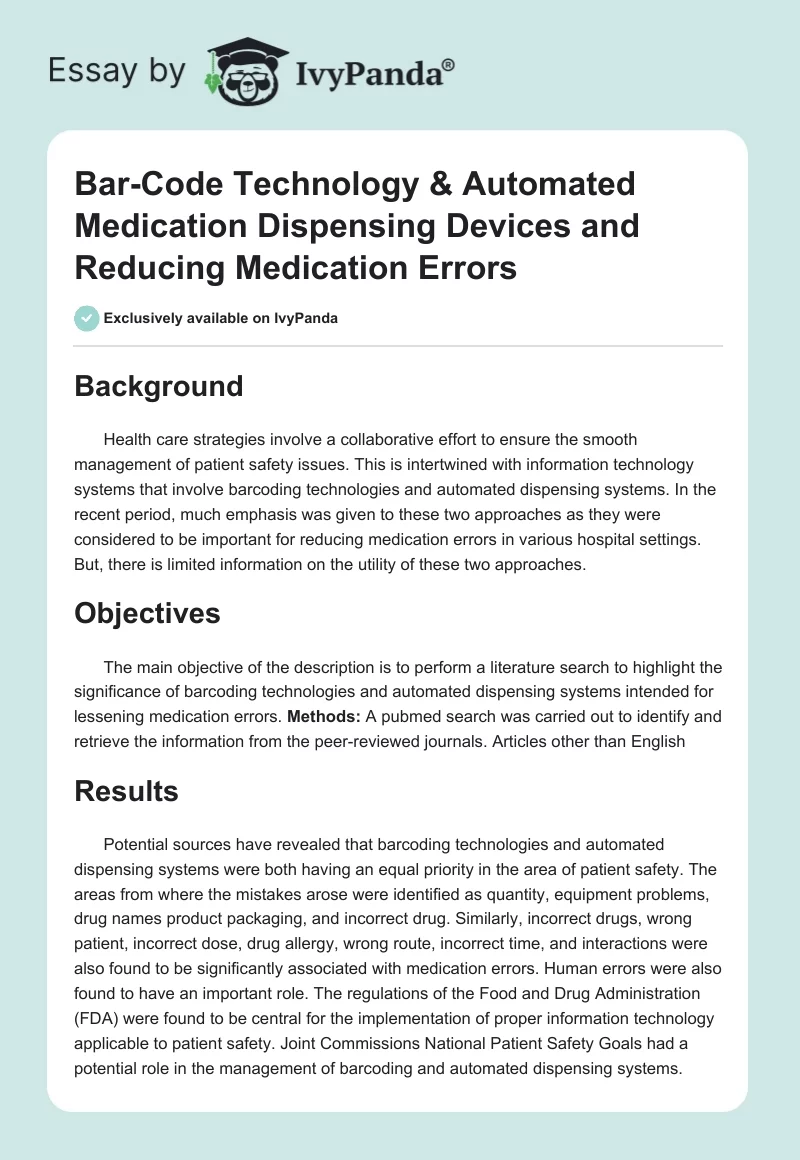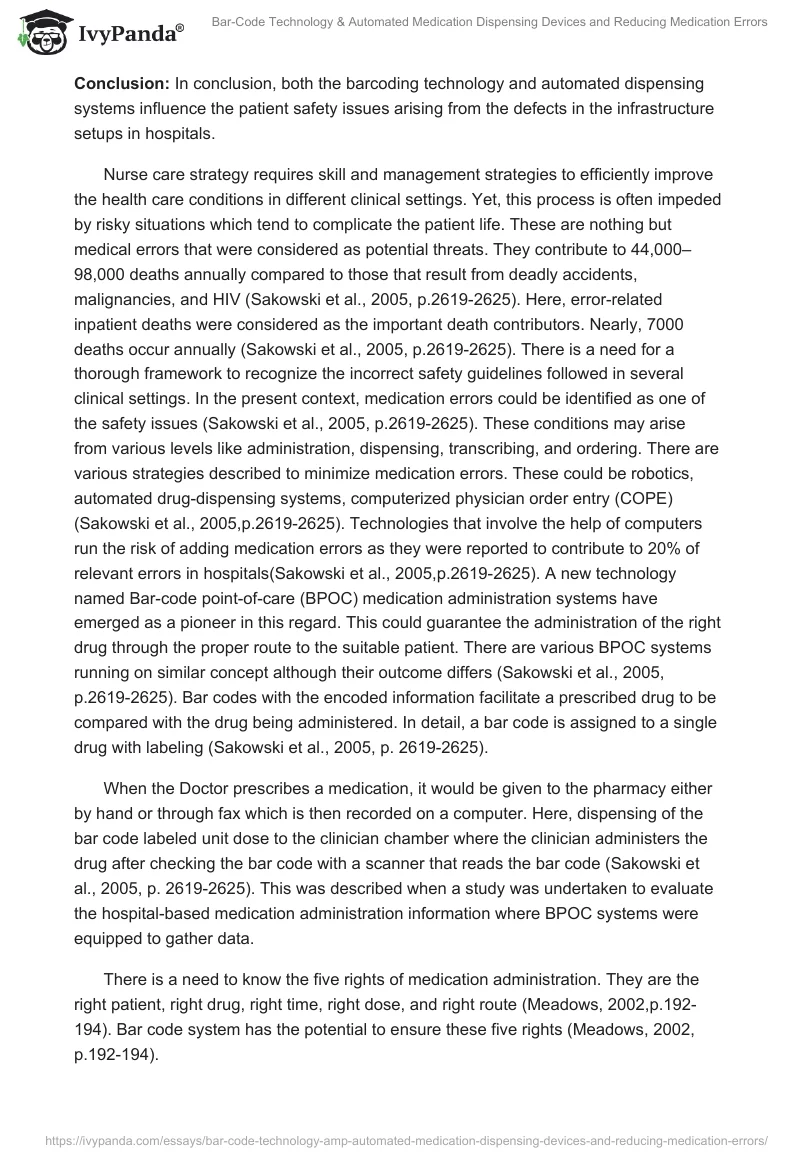Background
Health care strategies involve a collaborative effort to ensure the smooth management of patient safety issues. This is intertwined with information technology systems that involve barcoding technologies and automated dispensing systems. In the recent period, much emphasis was given to these two approaches as they were considered to be important for reducing medication errors in various hospital settings. But, there is limited information on the utility of these two approaches.
Objectives
The main objective of the description is to perform a literature search to highlight the significance of barcoding technologies and automated dispensing systems intended for lessening medication errors. Methods: A pubmed search was carried out to identify and retrieve the information from the peer-reviewed journals. Articles other than English
Results
Potential sources have revealed that barcoding technologies and automated dispensing systems were both having an equal priority in the area of patient safety. The areas from where the mistakes arose were identified as quantity, equipment problems, drug names product packaging, and incorrect drug. Similarly, incorrect drugs, wrong patient, incorrect dose, drug allergy, wrong route, incorrect time, and interactions were also found to be significantly associated with medication errors. Human errors were also found to have an important role. The regulations of the Food and Drug Administration (FDA) were found to be central for the implementation of proper information technology applicable to patient safety. Joint Commissions National Patient Safety Goals had a potential role in the management of barcoding and automated dispensing systems. Conclusion: In conclusion, both the barcoding technology and automated dispensing systems influence the patient safety issues arising from the defects in the infrastructure setups in hospitals.
Nurse care strategy requires skill and management strategies to efficiently improve the health care conditions in different clinical settings. Yet, this process is often impeded by risky situations which tend to complicate the patient life. These are nothing but medical errors that were considered as potential threats. They contribute to 44,000–98,000 deaths annually compared to those that result from deadly accidents, malignancies, and HIV (Sakowski et al., 2005, p.2619-2625). Here, error-related inpatient deaths were considered as the important death contributors. Nearly, 7000 deaths occur annually (Sakowski et al., 2005, p.2619-2625). There is a need for a thorough framework to recognize the incorrect safety guidelines followed in several clinical settings. In the present context, medication errors could be identified as one of the safety issues (Sakowski et al., 2005, p.2619-2625). These conditions may arise from various levels like administration, dispensing, transcribing, and ordering. There are various strategies described to minimize medication errors. These could be robotics, automated drug-dispensing systems, computerized physician order entry (COPE) (Sakowski et al., 2005,p.2619-2625). Technologies that involve the help of computers run the risk of adding medication errors as they were reported to contribute to 20% of relevant errors in hospitals(Sakowski et al., 2005,p.2619-2625). A new technology named Bar-code point-of-care (BPOC) medication administration systems have emerged as a pioneer in this regard. This could guarantee the administration of the right drug through the proper route to the suitable patient. There are various BPOC systems running on similar concept although their outcome differs (Sakowski et al., 2005, p.2619-2625). Bar codes with the encoded information facilitate a prescribed drug to be compared with the drug being administered. In detail, a bar code is assigned to a single drug with labeling (Sakowski et al., 2005, p. 2619-2625).
When the Doctor prescribes a medication, it would be given to the pharmacy either by hand or through fax which is then recorded on a computer. Here, dispensing of the bar code labeled unit dose to the clinician chamber where the clinician administers the drug after checking the bar code with a scanner that reads the bar code (Sakowski et al., 2005, p. 2619-2625). This was described when a study was undertaken to evaluate the hospital-based medication administration information where BPOC systems were equipped to gather data.
There is a need to know the five rights of medication administration. They are the right patient, right drug, right time, right dose, and right route (Meadows, 2002,p.192-194). Bar code system has the potential to ensure these five rights (Meadows, 2002, p.192-194).
For example, certain errors would be caught while using the Bar code system (Meadows, 2002). These may be Wrong drugs, wrong patient, incorrect dose, allergy to the drug, wrong route, incorrect time, and interactions (Meadows, 2002, 192-194). Bar code system also enables to maintain the proper billing system that reflects the drug administration, time, and clinician present. This would eliminate the use of manual documentation (Meadows, 2002). There were certain barriers to implementing the barcoding system.
Most Health care organizations failed to implement barcoding technology due to a lack of manufacture applied bar codes (Meadows, 2002, p.192-194). This could be alleviated by organizing workshops to bring about awareness among organizations. The use of bar code technology should be made mandatory. Food and Drug Administration (FDA) has passed a new regulation that prescribed drugs should have bar codes labeled (Meadows, 2002, p.192-194). Next, health care organizations working to improve patient safety should work on collaborations between hospitals.
Wakefield et al (2010) described that collaboration between rural referral hospitals and those critical access hospitals would help to streamline workflow procedures and methods. This could accelerate the progress of health information technologies (HITs) to improve medical care. The hospitals have successfully incorporated automated dispensing cabinets (ADC), electronic medical record (EMR), pharmacy information systems, computerized provider order entry, and barcode medication administration systems (Wakefield, Ward, Loes, O’Brien, 2010,p.584-587,). This was revealed when a questionnaire was conducted among hospitals to investigate the contributors that play important role in the success of ADC and barcode medication administration (Wakefield et al., 2010, p.584-587). Here, the parameters focused were the strategic placement of ADCs, interface among HIT components, shared culture of collaboration strategic placement of ADCs, discipline, planning, acquisition of sufficient HIT-related devices and outcomes (Wakefield, Ward, Loes, O’Brien, 2010,p.584-587,). This may indicate that the patient safety guidelines may involve collaborative efforts to enhance the performance of automated dispensing devices and minimize medication errors(Wakefield, Ward, Loes, O’Brien, 2010,p.584-587,). ADCs have emerged as indispensable tools in the medical information system in the recent period. They were being utilized for the storage of ready-to-use (RTU) and point-of-care (POC) activated parenteral products in U.S. hospitals were evaluated (Fanikos et al., 2007, p.2037-2043). This could serve as an aid to reduce medication errors. This was revealed when researchers conducted surveys that emphasized automated dispensing cabinets in U.S. hospitals (Wakefield et al., 2010). There was a significant response that reflected the utility of ADCs for storing RTU and POC products (Fanikos et al., 2007, p.2037-2043). But, this process has certain limitations as it is dependant on priorities, regulations, and characteristics of the facilities maintained at the individual level (Fanikos et al., 2007, 2037-2043).
However, the benefits of this process are improved safety benefits, enhanced dispensing potential, cost efficiency to decrease waste, and agreement with government regulations (Fanikos et al., 2007, 2037-2043). The safety issues focused on barcoding technology and automated dispensing systems have an association with the Joint Commissions National Patient Safety Goals (NPSG) (www.jointcommission.org). One of the NPSG goals was described on Hospital safety. Here, enhancing the accuracy of patient identification through patient two Patient Identifiers (NPSG.01.01.01), eliminating Transfusion Errors (NPSG.01.03.01), enhancing the communication among care providers, timely reporting, and enhancing the safety of using medications(www.jointcommission.org). Because of the above information, reducing medication errors is tightly linked with a spectrum of information technology devices and their efficient management. This also involves skill and expertise from the nurse and professional medical personnel. Barcoding technology was found to be the most easily adaptable technology in hospitals. This in combination with an automated dispensing cabinet system would further improve the management of patients who become susceptible to faulty medication errors linked to a lack of correct infrastructure across hospitals.
There is a need of implementing this practice in an evidence-based practice approach at several hospitals. A thorough survey should be conducted across hospitals to identify the defects contributing to the medication errors. A study emphasizing devices usage, information entry, management, and staffing could yield a better outcome. It is important for the government authorities to interfere with the right interventions like awareness programs starting from rural settings to highlight the significance of barcoding systems ad automated dispensing systems. Manufacturing units of these devices should also maintain standards and adhere to guidelines imposed by federal and state agencies to avoid potentially risky consequences that might arise.
References
- Fanikos, J., Abbie Erickson, Kristin E. Munz, Mike D. Sanborn, Brad C. Ludwig and Tom Van Hassel (2007). Observations on the use of ready-to-use and point-of-care activated parenteral products in automated dispensing cabinets in U.S. hospitals. Am J Health Syst Pharm, 64, 2037-43.
- Meadows, G., (2002).Nursing Economics, 4,192-194.
- NPSG Chapter Outline and Overview Hospital. Web.
- Sakowski, J.,Thomas Leonard, Susan Colburn,Beverely Michaelsen,Timothy Schiro, James Schneider, Jeffrey M.Newman(2005). Am J Health-Syst Pharm, 62,2619-25
- Wakefield, D,S., Ward, M,M., Loes, J,L., O’Brien, J. (2010). A network collaboration implementing technology to improve medication dispensing and administration in critical access hospitals. J Am Med Inform Assoc, 17,584-7.


